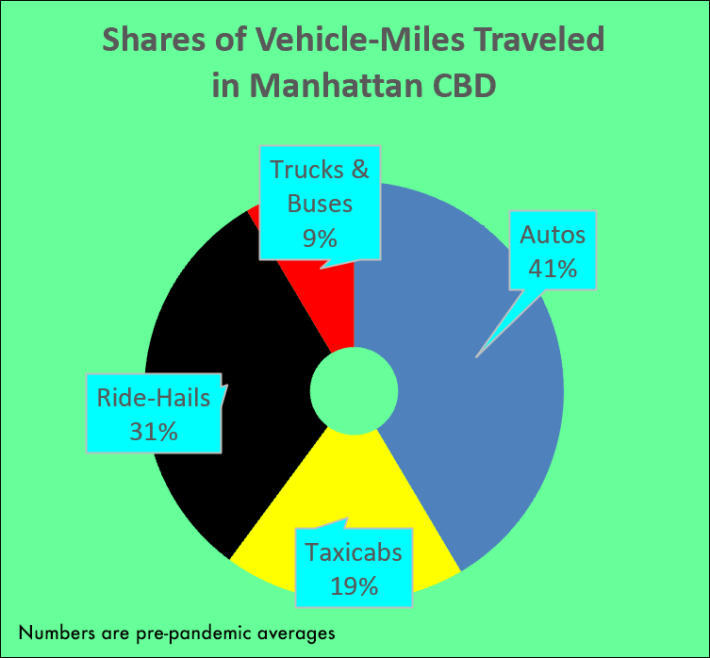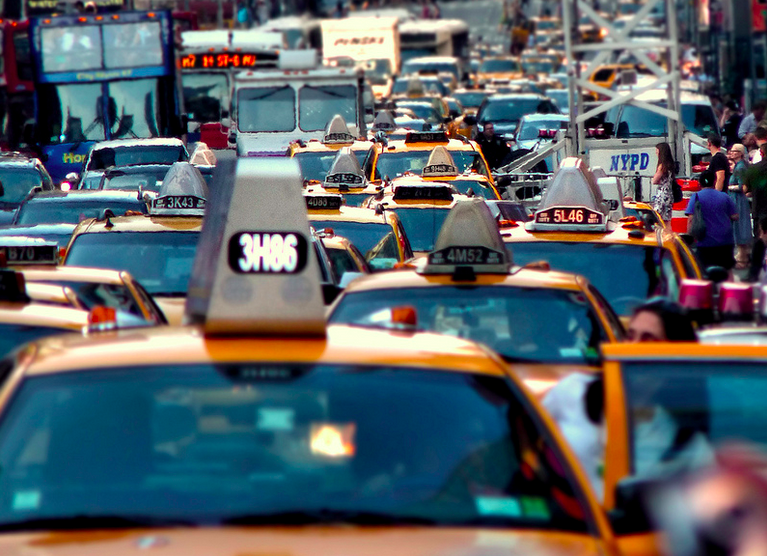For-hire vehicles — taxis, Ubers and Lyfts — shouldn’t be an afterthought to congestion pricing. They deserve their own policy lane.
Before the pandemic, for-hires accounted for half of all miles driven in the Manhattan Central Business District. Nearly 20 percent of the total was taxis, a little over 30 percent was ride-hail Ubers and Lyfts.

Those shares have shrunk, but FHVs remain a huge and distinct mode with lesser social impact than private cars. Since they’re closely regulated, we can devise a granular congestion charge that is, frankly, brilliant.
The idea has five parts:
- Repeal the MTA surcharges that since early 2019 have collected $2.50 per taxi ride ($2.75 for Ubers and Lyfts) that touches the Manhattan taxi zone (everything south of 96th Street).
- Determine how much money the surcharges have been depositing with the MTA, and make that the new scheme’s revenue floor.
- Charge each FHV passenger trip a set rate — more in daytime, less at night — for every minute the vehicle is traveling in the Manhattan taxi zone. Set the rate so the total annual revenue equals that from the surcharge.
- No entry fee for FHVs, since that function will be performed by part 3.
- Additionally charge Uber and Lyft for each minute their vehicles are anywhere in the zone without a passenger, to discourage vehicle stockpiling in the congested CBD. [As a reminder, Streetsblog has covered the city's failed effort to institute such a charge here.]
Charging the for-hires for each passenger-minute in the Manhattan taxi zone is quintessential congestion pricing — and more effective against Manhattan congestion than the MTA’s one-size-fits-all FHV surcharge.
Charging FHVs by the minute means the charge rises as a trip covers longer distances in highly congested traffic. These higher charges will deter trips that congest traffic the most. For a given level of revenue, per-minute FHV surcharging cuts travel delays considerably more than the current MTA surcharge, according to my modeling.
How high should the charges be? Before the pandemic, I calculated that applying a taxi-zone congestion charge of 20 cents a minute (10 cents off-peak) when the taxi or Uber is in Manhattan south of 96th Street with a passenger would replicate the MTA surcharge revenues. Though those revenues are down, the relationship between the different fees probably hasn’t changed. Twenty cents a minute is probably a good approximation of the right surcharge rate.
With that charge, a trip in an Uber or Lyft or yellow that covers two miles in the zone when traffic is inching along at 6 mph would be surcharged $4. (I computed that as 10 minutes/mile (based on 6 mph) x two miles x $0.20/minute.) An FHV trip of half the distance or done at double the speed would be surcharged half as much, $2, while a trip half the distance AND double the speed would be surcharged one-fourth as much, $1.

This covers element #3 above. But there’s also element #5: an additional “stockpiling surcharge” on Uber and Lyft for each minute their vehicles are in the taxi zone without a passenger. This will discourage Ubers and Lyfts from hogging scarce Manhattan curb or lane space merely so that twitchy customers can shave a minute or two off their waiting time.
In Curbing FHV Stockpiling in the Manhattan Core, my report for the city council (and covered by Streetsblog earlier this year), I found that a supplemental 11-cent Uber and Lyft surcharge for each minute their affiliated vehicles are in the Manhattan taxi zone with no passenger would recoup the added congestion in proportion to the likely $13 peak round-trip congestion toll on private autos. This extra surcharge would raise $80 million in additional annual revenue, money that could be earmarked to a dedicated transportation purpose (my vote goes to the transit-desert e-bike program I touted in Ginia Bellafante’s weekend NY Times column).
Why surcharge ride-hail companies, but not yellow cabs, for stockpiling? For one thing, the volume of taxicabs is a tiny fraction of the number of ride-hail vehicles, a difference that manifests as a far lesser drag on traffic. In addition, taxis’ business model depends on their circulating without a passenger, making it gratuitous to charge them for empty minutes. Moreover, by purchasing medallions, taxi owners invested equity in exchange for exclusive franchise rights, which ride-hail services grossly breached; the empty-ride-hail charge (element #5) restores some of the lost equity by making taxi service more competitive.
Finally, why not congestion-charge all vehicles in the CBD by the minute? I’d love to. Continuous, granulated congestion tolling is far more efficient than binary. Unfortunately, administering per-minute or even per-mile tolls can’t be done without the tolling authority tapping every vehicle’s GPS. Not. Happening. Now.
At present, regulated vehicles like for-hires, or delivery fleets, which I’ll be tackling in a forthcoming report, can be the gateway to granulated tolling. New York’s congestion pricing pause, though dreadful, can be where this more-efficient and equitable form of congestion tolling gets its start.
Charles Komanoff is the leading expert on congestion pricing modeling and also an occasional consultant to the taxi industry. The current version of Komanoff’s BTA model can always be downloaded via this link. Requires PC or Mac Excel (will not run on Google docs).






